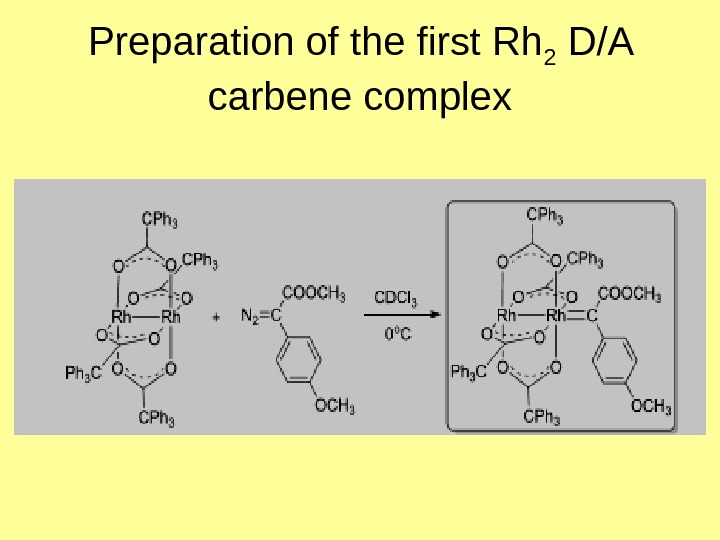Metal–metal multiple bonded intermediates in catalysis (for example,













metalmetal_multiple_bonded_intermediates_in_catalysis.ppt
- Размер: 1.5 Mегабайта
- Количество слайдов: 13
Описание презентации Metal–metal multiple bonded intermediates in catalysis (for example, по слайдам
 Metal–metal multiple bonded intermediates in catalysis (for example, Rh 2 and Ru 2 complexes )
Metal–metal multiple bonded intermediates in catalysis (for example, Rh 2 and Ru 2 complexes )
 Overview of Rh 2 -catalysed C–H functionalization and C–H anination chemistries
Overview of Rh 2 -catalysed C–H functionalization and C–H anination chemistries
 Rh 2 carbene chemistry The key electronic feature of this intermediate is delocalized Rh–Rh–C three-centre bonding with appropriate three-centre orbitals of σ and π symmetry
Rh 2 carbene chemistry The key electronic feature of this intermediate is delocalized Rh–Rh–C three-centre bonding with appropriate three-centre orbitals of σ and π symmetry
 Trends in reactivity for the different classes of organic diazo compounds
Trends in reactivity for the different classes of organic diazo compounds
 Preparation of the first Rh 2 D/A carbene complex
Preparation of the first Rh 2 D/A carbene complex
 Rh 2 nitrene chemistry Rh 2 -catalysed nitrenoid chemistry is mechanistically more complex than the corresponding carbenoid chemistry
Rh 2 nitrene chemistry Rh 2 -catalysed nitrenoid chemistry is mechanistically more complex than the corresponding carbenoid chemistry
 Reactions using pre-formed iminoiodinane compounds (a) – intramolecular cyclization (b) – intermolecular reaction
Reactions using pre-formed iminoiodinane compounds (a) – intramolecular cyclization (b) – intermolecular reaction
 Proposed mechanism for intermolecular C–H amination Organic groups on the catalyst are removed for clarity
Proposed mechanism for intermolecular C–H amination Organic groups on the catalyst are removed for clarity
 Ru 2 n itrido chemistry Rh–Rh=E M–M=E Ru–Ru≡ N structures structure (E = CR 2 / NR) The first Ru 2 nitrido compound – Ru 2 (DPh. F) 4 N (DPh. F = N, N′-diphenylformamidinate) – was found to be thermally unstable In an effort to understand the nature of this instability, the related Ru 2 (D(3, 5 -Cl 2 )Ph. F) 4 N 3 azide complex was investigated
Ru 2 n itrido chemistry Rh–Rh=E M–M=E Ru–Ru≡ N structures structure (E = CR 2 / NR) The first Ru 2 nitrido compound – Ru 2 (DPh. F) 4 N (DPh. F = N, N′-diphenylformamidinate) – was found to be thermally unstable In an effort to understand the nature of this instability, the related Ru 2 (D(3, 5 -Cl 2 )Ph. F) 4 N 3 azide complex was investigated
 Crystal structure of Ru 2 [(D(3, 5 -Cl 2 )Ph. F) 3 (D(3, 5 -Cl 2 -2 -N H)Ph. F)]
Crystal structure of Ru 2 [(D(3, 5 -Cl 2 )Ph. F) 3 (D(3, 5 -Cl 2 -2 -N H)Ph. F)]
 Synthetic cycle for N-atom transfer using the Ru 2 (chp) 4 core
Synthetic cycle for N-atom transfer using the Ru 2 (chp) 4 core
 Summary Efforts to identify reactive metal–metal bonded complexes having a linear M–M=E structure have led to the observation of important intermediates in Rh 2 -catalysed carbenoid and nitrenoid transformations. Inspired by the structures of these intermediates, chemists have been able to explore novel reactivity of the Ru–Ru≡N core including intramolecular C–H amination as well as intermolecular N atom transfer.
Summary Efforts to identify reactive metal–metal bonded complexes having a linear M–M=E structure have led to the observation of important intermediates in Rh 2 -catalysed carbenoid and nitrenoid transformations. Inspired by the structures of these intermediates, chemists have been able to explore novel reactivity of the Ru–Ru≡N core including intramolecular C–H amination as well as intermolecular N atom transfer.
 Source J. Chem. Sci. Vol. 127, No. 2, February 2015, pp. 209– 214. Indian Academy of Sciences. DOI 10. 1007/s 12039 -015 -0773 -6 JOHN F BERRY Department of Chemistry, University of Wisconsin – Madison, 1101 University Ave. , Madison, WI 53706, USA e-mail: berry@chem. wisc. edu MS received 19 May 2014; accepted 17 July 2014 The presentation was prepared by Maxim Pavchenko
Source J. Chem. Sci. Vol. 127, No. 2, February 2015, pp. 209– 214. Indian Academy of Sciences. DOI 10. 1007/s 12039 -015 -0773 -6 JOHN F BERRY Department of Chemistry, University of Wisconsin – Madison, 1101 University Ave. , Madison, WI 53706, USA e-mail: berry@chem. wisc. edu MS received 19 May 2014; accepted 17 July 2014 The presentation was prepared by Maxim Pavchenko
